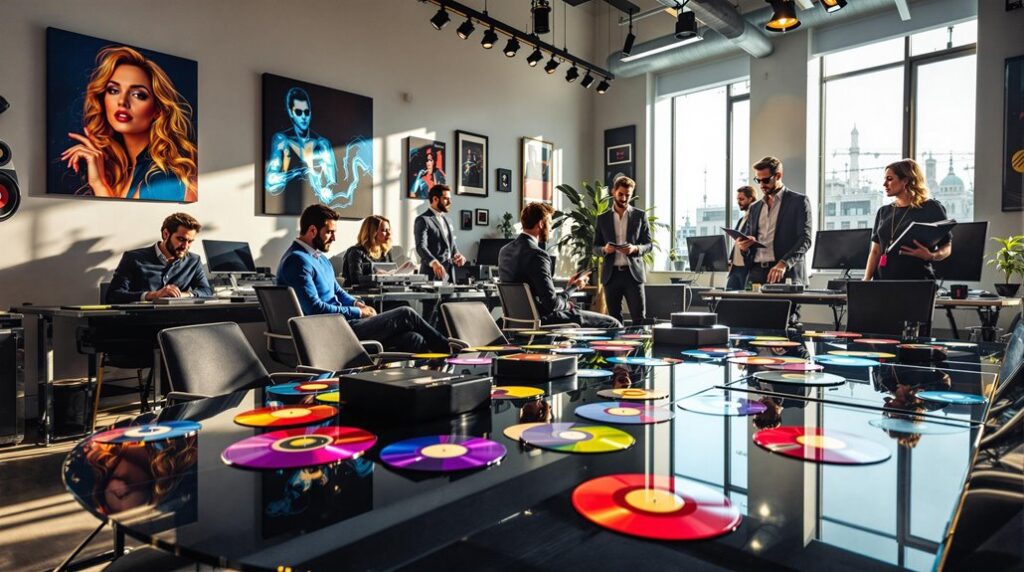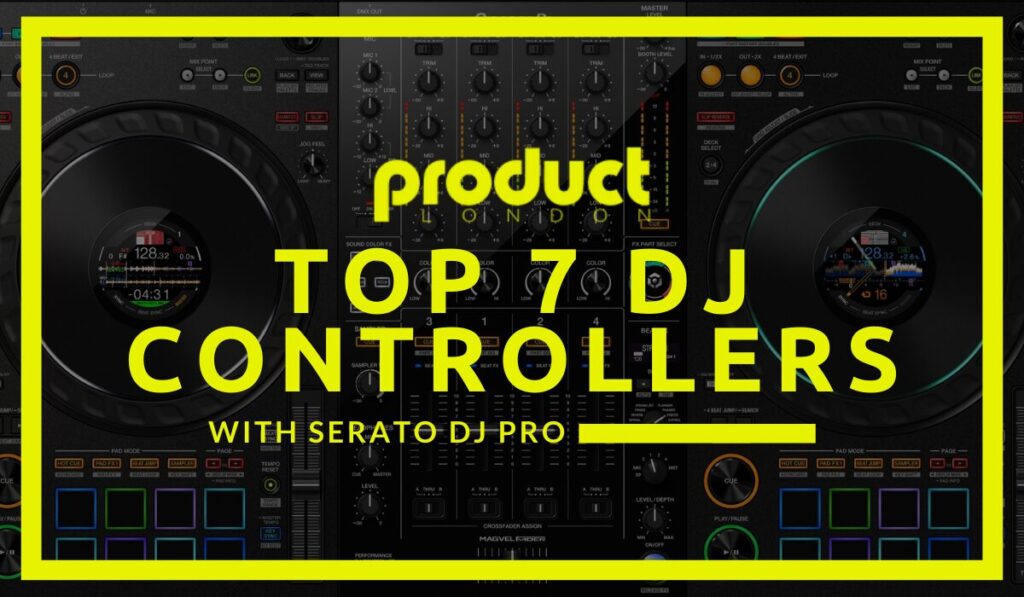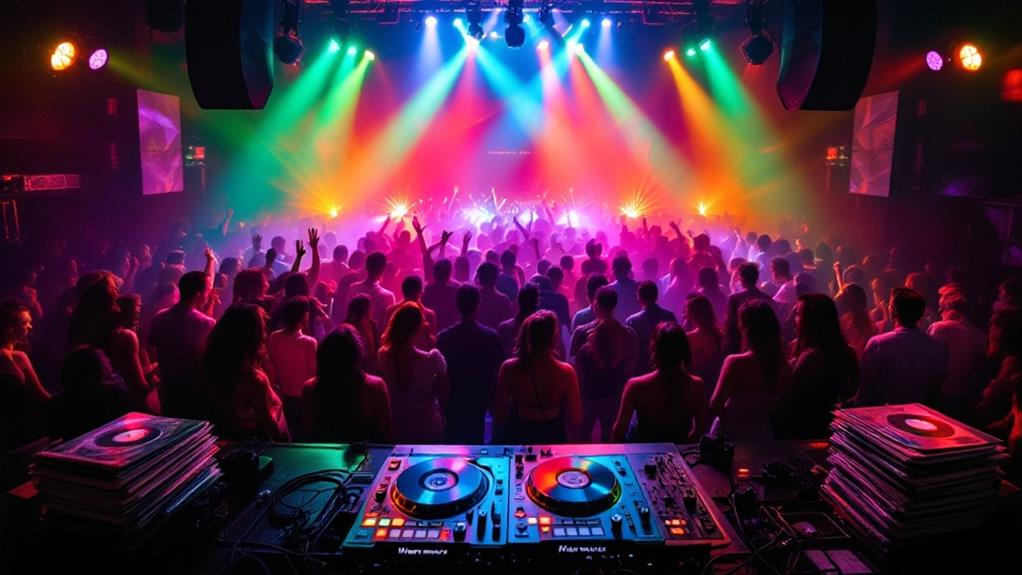Begin your DJing journey by understanding different roles such as club, mobile, and radio DJs, each requiring unique skills and audience engagement strategies. Equip yourself with essential gear including a DJ controller, headphones, and audio mixers to execute seamless performances. Develop core skills like beatmatching, crossfading, and looping to craft engaging sets. Expand your music library through genre exploration and maintain updates via digital platforms, ensuring a dynamic repertoire. Secure your first gig through strategic networking, demo mixes, and online promotion. Advance further to uncover techniques that will enhance your DJing capabilities to professional levels.
Key Takeaways
- Begin with a DJ controller for an affordable and space-efficient setup, ideal for beginners.
- Master beatmatching to align track tempos, crucial for seamless transitions in performances.
- Organize your music library by genre and mood for efficient access during sets.
- Practice EQ adjustments to enhance sound clarity and maintain a cohesive audio experience.
- Record mixes to track progress and identify areas for improvement in your skills.
Understanding Different DJ Roles
In the dynamic landscape of the music industry, understanding the various DJ roles is essential for any aspiring DJ seeking to carve out a niche.
Club DJs are at the forefront of club culture, tasked with the crucial role of sustaining the energy on the dance floor. Their expertise in mixing tracks is not just about seamless shifts but about reading the crowd and adapting to their energy, ensuring constant audience engagement. This role demands an acute sense of timing and music knowledge, as the ability to keep the atmosphere vibrant can greatly influence their earnings, which range from complimentary perks to over $2,000 per gig for those with proven skill and popularity.
Remarkably, Missy Jay exemplifies this role with her high-energy sets and enthralling performances at prestigious venues.
Conversely, Mobile DJs bring versatility to private events such as weddings and corporate functions. Their success hinges on strong technical proficiency and adaptability to diverse audiences. Often, their specialized services command higher fees than those of Club DJs, reflecting their ability to engage varied audience demographics effectively.
Meanwhile, Radio DJs focus on curating and presenting music to engage listeners, blending tracks seamlessly with engaging commentary.
Each role within the DJ landscape provides unique opportunities for audience engagement and mastering the art of music curation.
Essential DJ Equipment
When starting on the journey to become a DJ, having the right equipment is essential. A DJ controller is often the first choice for beginners due to its space-efficient design that combines mixer and deck functionalities. Make sure to choose a model that offers seamless integration with your preferred DJ software for an efficient workflow.
Entry-level models, priced around £79, offer a user-friendly interface ideal for those just beginning to explore mixing. For those drawn to a more traditional approach, vinyl turntables provide an authentic tactile experience. However, they require a more significant investment and an understanding of vinyl maintenance.
Audio mixers are important for any DJ setup, allowing seamless blending of audio from multiple sources. They typically feature various channels and EQ controls that enable the DJ to adjust sound levels and frequencies, ensuring a dynamic performance.
Quality headphones are crucial for cueing tracks and monitoring sound, enabling precision in track preparation without audience interference.
When it comes to sound output, PA systems are essential for live performances, delivering clear audio to the audience. For home practice, studio monitors, starting at approximately £150, offer detailed sound reproduction.
In contrast, professional setups for larger events can run into thousands, ensuring best sound quality and coverage.
Learning Core DJ Skills
Mastering core DJ skills is foundational for anyone aspiring to excel in the art of DJing. Central to this is understanding beatmatching techniques, which are essential for aligning the tempos of two tracks, ensuring smooth shifts that keep the rhythm flowing. With dedicated practice, these techniques can be mastered in under 30 minutes, providing an important building block for more advanced mixing styles. Equally important is familiarizing oneself with various mixing techniques such as crossfading, looping, and EQ adjustments. These skills contribute to maintaining a cohesive sound that captivates audiences throughout a set.
| Core Skill | Description |
|---|---|
| Beatmatching | Aligns track tempos for seamless shifts. |
| Crossfading | Smoothly shifts between tracks using fader controls. |
| Looping | Repeats a section of a track for creative mixing. |
| EQ Adjustments | Balances frequencies to enhance sound clarity. |
| Recording Mixes | Provides feedback and tracks progress for skill refinement. |
Additionally, DJs must develop the ability to read the crowd. This involves gauging audience energy and mood to adjust setlists accordingly, ensuring an engaging and dynamic performance. Regularly recording and reviewing mixes can further refine these skills, providing valuable insights into personal progress and areas for improvement.
Building Your Music Library
A well-curated music library is an essential asset for any aspiring DJ, laying the foundation for creative and engaging performances. To build a versatile track collection, start by exploring a wide range of genres. This approach caters to diverse audience tastes and event types, enhancing your adaptability as a DJ.
Employ effective music discovery techniques by utilizing digital platforms like Beatport and SoundCloud. These resources help you stay updated with new tracks and trends, ensuring your selections remain fresh and enthralling. Additionally, joining music subscription services like BPM Supreme or DJcity can provide access to DJ-optimized tracks and keep your library current.
To streamline your DJ sets, employ playlist organization strategies. Categorize your tracks into playlists based on mood, tempo, or event type, which facilitates quick and efficient access during live performances.
Consider the following steps when building your library:
- Explore various music genres to diversify your track selection.
- Use digital platforms such as Beatport and SoundCloud for discovering new music.
- Organize tracks by mood, tempo, and event type for efficient set preparation.
- Regularly update your library with new releases and remixes to maintain creative dynamism.
Lastly, adhere to licensing and copyright regulations when sourcing music. Platforms like InFlyte offer promotional tracks that expand your library legally, keeping your performances both dynamic and compliant.
Getting Your First DJ Gig
Securing your first DJ gig requires strategic networking and proactive engagement with the local music scene. Start by connecting with local DJs and event promoters, as personal relationships often pave the way to initial opportunities. Demonstrating your enthusiasm and readiness to perform can greatly increase your chances.
Consider utilizing online platforms to boost your visibility and explore gig opportunities. As part of your networking strategies, consider offering your services for free or at a reduced rate for smaller local events, such as house parties or community gatherings. This approach not only helps you gain valuable experience but also builds a portfolio that can be used for future promotions.
Creating a compelling demo mix that highlights your unique style and technical skills is essential. This mix serves as an auditory resume, showcasing your capabilities to potential venues or promoters. Distribute your demo strategically to places that host DJ nights or open mic events, which are often more inclined to book emerging talent.
Complement your networking efforts with robust gig promotion through social media. Regularly share your mixes and interact with your audience to enhance your visibility and attractiveness to event organizers.
Frequently Asked Questions
How to Start DJING for Beginners?
To start DJing, invest in essential equipment like a DJ controller and mixer. Learn beginner techniques such as beatmatching through online resources. Practice consistently and build a versatile music library. Engage with the community for real-world experience.
How Do I Teach Myself to Be a DJ?
To teach yourself DJing, invest in DJ equipment, explore software options for mixing techniques, and focus on beat matching. Curate diverse music selections, experiment with genre exploration, practice live performances, and utilize networking tips for growth.
What Is the Rule of 32 in DJING?
The Rule of 32 in DJing refers to changing tracks every 32 bars, optimizing beat matching and mixing techniques. This enhances rhythmic alignment and dynamic flow, maintaining audience engagement, particularly in genres like house and techno with structured phrases.
What Age Is Too Late to Start DJING?
Age considerations in DJing reveal no definitive limit; late starters can achieve success through dedication and practice. Prominent DJs began later in life, proving that passion and persistence are more essential than age for a thriving career.
Conclusion
Mastering the art of DJing involves comprehending various DJ roles, acquiring essential equipment, and honing core skills. A well-curated music library is vital for versatility and audience engagement. Aspiring DJs must also navigate the intricacies of securing initial gigs, which are pivotal for gaining experience and exposure. Through dedication to these foundational elements, one can lay a solid groundwork for a successful DJ career, continuously evolving with trends and technological advancements in the dynamic landscape of music entertainment.




